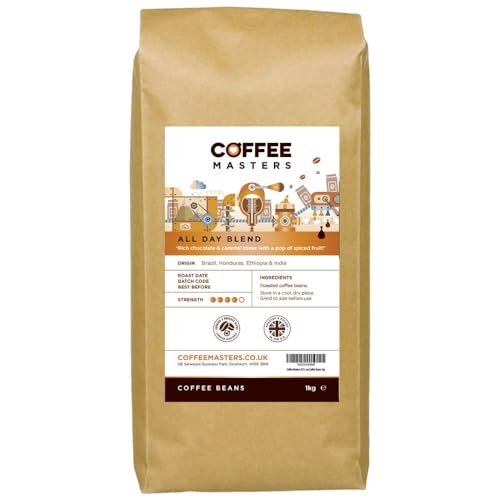15 Up-And-Coming Trends About Coffee Beans Types
 Josefa
0
49
2024.11.23 12:24
Josefa
0
49
2024.11.23 12:24
Coffee Bean Types: Arabica, Robusta, Liberica, and Excelsa
If you're a fan of coffee you're probably aware that different types of beans can produce different flavors. Learn about four of the most well-known varieties: Arabica. Robusta. Liberica. and Excelsa.
Excelsa beans are a variety of Liberica that is only grown in Southeast Asia. They have a fruitier and tarter taste profile and are often utilized in blends of beans to give them added depth.
Arabica
Arabica is the most sought-after coffee worldwide with 75% of the world's coffee bean production. Arabica beans are milder and have a sweeter flavor than Robusta and are available with a variety of flavor profiles. The aroma and taste of coffee is affected by the conditions in the conditions it is grown and the methods of processing used.
The word "coffee" is derived from the Arabic word meaning berry. Coffee beans are actually seeds that grow in bright red berries. It is believed that ancient Ethiopian shepherds discovered that their goats were energized by eating the berries. The cultivation of coffee grew rapidly around the world.
Coffee beans can be grown at higher altitudes, and are able to thrive when exposed to cold temperatures and plenty of rain. This is the reason Arabica coffee is believed to be the most delicious type of Bulk coffee Beans.
Many specialty coffee roasters and shops concentrate on using ethically-sourced arabica beans, by emphasizing fair wages for farmers and sustainable farming practices. These companies typically blend arabica beans to create unique coffees that can be used in many methods of brewing. Blending is a way to control the flavour, aroma and body as well as the acidity of the coffee beans bulk. It is frequently preferred to create a consistent and balanced taste that appeals to a larger market.
Robusta
Robusta beans are the second-most popular kind of coffee bean in the world. They contain more caffeine per bean and are more resistant against diseases and pests. They also contain more chlorogenic acids, which are naturally-occurring antioxidants. These acids can cause oxidation during the coffee brewing and produce undesirable flavors.
The plant is more durable than the arabica and is able to grow in less favorable conditions. It can tolerate higher temperatures and thrives in direct sunlight. It is faster growing and produces more coffee per plant than arabica, making it a cheaper crop to cultivate.
Although it might appear counterintuitive it's true that Robusta beans are often mixed with arabica to create coffee blends. If you notice names like Uganda or Kenya on the coffee bags, it's possible that there is also some robusta.
While some roasters exclusively use arabica beans, the majority use combine the two varieties to reduce cost and maintain good quality coffee beans. To preserve the integrity of flavor, you should choose the best quality beans from a reliable source. The best method to achieve this is to buy your beans directly from the farmer.
Liberica
Liberica beans have a shape like a football, which is what makes them distinct from other coffee beans. They have a distinctive scent that is floral and fruity with smokey undertones. They are often added to other types of 500g coffee beans beans to give them a richer, more robust taste.
Liberica coffee beans are available in West Africa, Malaysia (Borneo) and Southeast Asia. They can thrive in low altitudes and tolerate hot, humid climates. They are also more resistant to diseases than Arabica or Robusta.
These qualities make them ideal for home-growing. You can purchase the seeds from many sources. However, it's ideal to purchase the beans from local producers in order to ensure quality. The ideal conditions for the cultivation of Liberica coffee plants include fertile deep volcanic soils that have moderately acidic pH, and adequate annual rainfall.
Another kind of coffee bean is Excelsa that was once considered to be a separate species but was re-classified as a variant of Liberica. These coffee beans are ovals that are grown on large 20 to 30-foot coffee plants at moderate altitudes. Their unique taste is both tart and sour, making them a popular choice for blends that are house-made. They have a less pronounced aroma and higher caffeine content that is lower than Arabica or Robusta but they still have a distinct flavor.
Excelsa
Excelsa coffee beans aren't as common as Arabica and Robusta, even though they are the fourth most popular. In fact they were regarded as distinct species of coffee until 2006 when they were classified as a synonym for Coffea liberica var. dewevrei. They are grown in Southeast Asia today and account for 7% of the global production of coffee. The coffee beans are distinctive with a teardrop-shaped shape and possess a dark, mysterious flavor. They are frequently utilized to give blends extra body and a tangy taste of ripened fruits.
Arabica beans are the most well-known, and are renowned for their an apricot-like flavor. They thrive in tropical and warm climates and at high altitudes. They also have a bit of acidity. If they are brewed correctly and roast properly they can be flavored like nuts, chocolate or even fruit.
Robusta is the second most-loved coffee in the world and is responsible for 40% of all coffee consumed around the world. Robusta beans are more round and smaller, but they have twice the amount of caffeine as Arabica. They also have more bitterness than the other two varieties, and tend to have earthy and woody overtones.
After having a better understanding of the four most commonly used types of brew, it's time to select the best brew. If you prefer a smooth and delicate flavor opt for an arabica or a blend of robusta and arabica beans.
If you're a fan of coffee you're probably aware that different types of beans can produce different flavors. Learn about four of the most well-known varieties: Arabica. Robusta. Liberica. and Excelsa.
Excelsa beans are a variety of Liberica that is only grown in Southeast Asia. They have a fruitier and tarter taste profile and are often utilized in blends of beans to give them added depth.
Arabica
Arabica is the most sought-after coffee worldwide with 75% of the world's coffee bean production. Arabica beans are milder and have a sweeter flavor than Robusta and are available with a variety of flavor profiles. The aroma and taste of coffee is affected by the conditions in the conditions it is grown and the methods of processing used.
The word "coffee" is derived from the Arabic word meaning berry. Coffee beans are actually seeds that grow in bright red berries. It is believed that ancient Ethiopian shepherds discovered that their goats were energized by eating the berries. The cultivation of coffee grew rapidly around the world.
Coffee beans can be grown at higher altitudes, and are able to thrive when exposed to cold temperatures and plenty of rain. This is the reason Arabica coffee is believed to be the most delicious type of Bulk coffee Beans.
Many specialty coffee roasters and shops concentrate on using ethically-sourced arabica beans, by emphasizing fair wages for farmers and sustainable farming practices. These companies typically blend arabica beans to create unique coffees that can be used in many methods of brewing. Blending is a way to control the flavour, aroma and body as well as the acidity of the coffee beans bulk. It is frequently preferred to create a consistent and balanced taste that appeals to a larger market.
Robusta
Robusta beans are the second-most popular kind of coffee bean in the world. They contain more caffeine per bean and are more resistant against diseases and pests. They also contain more chlorogenic acids, which are naturally-occurring antioxidants. These acids can cause oxidation during the coffee brewing and produce undesirable flavors.
The plant is more durable than the arabica and is able to grow in less favorable conditions. It can tolerate higher temperatures and thrives in direct sunlight. It is faster growing and produces more coffee per plant than arabica, making it a cheaper crop to cultivate.
Although it might appear counterintuitive it's true that Robusta beans are often mixed with arabica to create coffee blends. If you notice names like Uganda or Kenya on the coffee bags, it's possible that there is also some robusta.
While some roasters exclusively use arabica beans, the majority use combine the two varieties to reduce cost and maintain good quality coffee beans. To preserve the integrity of flavor, you should choose the best quality beans from a reliable source. The best method to achieve this is to buy your beans directly from the farmer.
Liberica
Liberica beans have a shape like a football, which is what makes them distinct from other coffee beans. They have a distinctive scent that is floral and fruity with smokey undertones. They are often added to other types of 500g coffee beans beans to give them a richer, more robust taste.
Liberica coffee beans are available in West Africa, Malaysia (Borneo) and Southeast Asia. They can thrive in low altitudes and tolerate hot, humid climates. They are also more resistant to diseases than Arabica or Robusta.
These qualities make them ideal for home-growing. You can purchase the seeds from many sources. However, it's ideal to purchase the beans from local producers in order to ensure quality. The ideal conditions for the cultivation of Liberica coffee plants include fertile deep volcanic soils that have moderately acidic pH, and adequate annual rainfall.
Another kind of coffee bean is Excelsa that was once considered to be a separate species but was re-classified as a variant of Liberica. These coffee beans are ovals that are grown on large 20 to 30-foot coffee plants at moderate altitudes. Their unique taste is both tart and sour, making them a popular choice for blends that are house-made. They have a less pronounced aroma and higher caffeine content that is lower than Arabica or Robusta but they still have a distinct flavor.
Excelsa
Excelsa coffee beans aren't as common as Arabica and Robusta, even though they are the fourth most popular. In fact they were regarded as distinct species of coffee until 2006 when they were classified as a synonym for Coffea liberica var. dewevrei. They are grown in Southeast Asia today and account for 7% of the global production of coffee. The coffee beans are distinctive with a teardrop-shaped shape and possess a dark, mysterious flavor. They are frequently utilized to give blends extra body and a tangy taste of ripened fruits.
Arabica beans are the most well-known, and are renowned for their an apricot-like flavor. They thrive in tropical and warm climates and at high altitudes. They also have a bit of acidity. If they are brewed correctly and roast properly they can be flavored like nuts, chocolate or even fruit.
Robusta is the second most-loved coffee in the world and is responsible for 40% of all coffee consumed around the world. Robusta beans are more round and smaller, but they have twice the amount of caffeine as Arabica. They also have more bitterness than the other two varieties, and tend to have earthy and woody overtones.
After having a better understanding of the four most commonly used types of brew, it's time to select the best brew. If you prefer a smooth and delicate flavor opt for an arabica or a blend of robusta and arabica beans.



